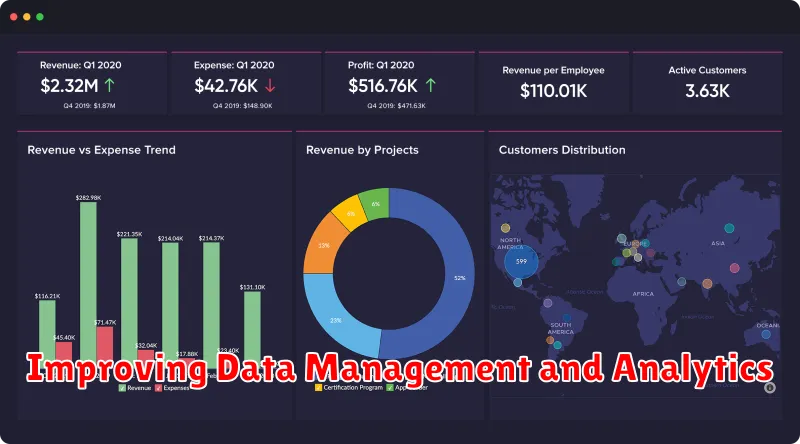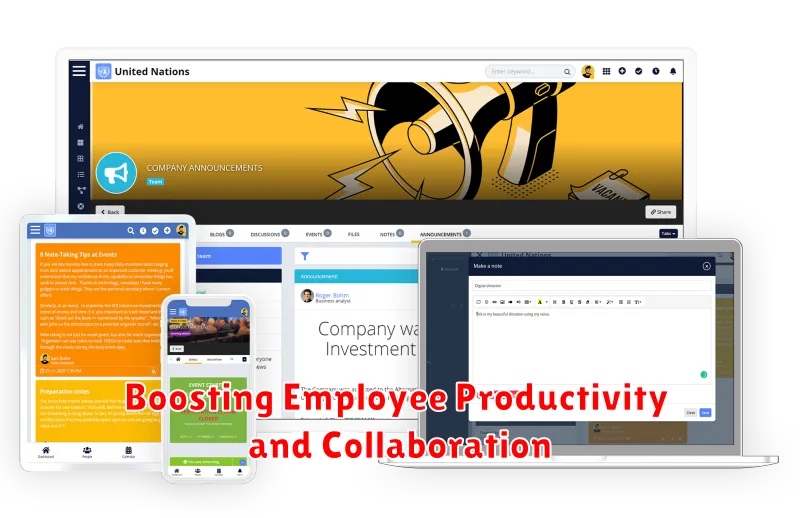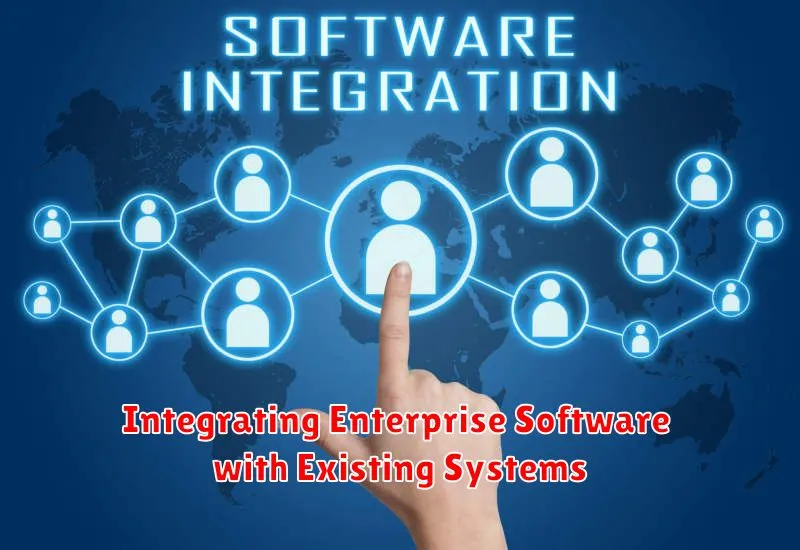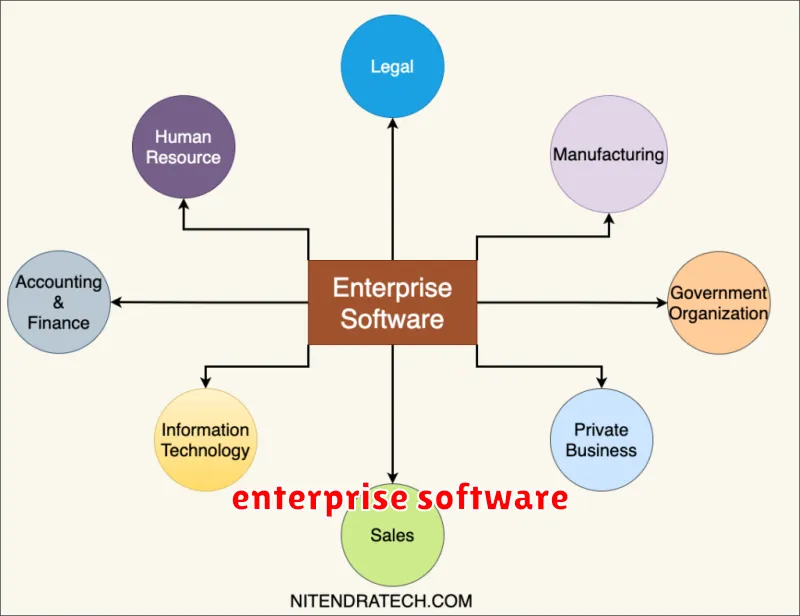In today’s dynamic business landscape, staying ahead of the competition requires more than just a great product or service. It demands the ability to operate efficiently, make data-driven decisions, and adapt to changing market conditions with agility. This is where enterprise software solutions come into play. By leveraging cutting-edge technology, these solutions empower businesses to streamline operations, automate processes, and gain valuable insights that drive growth and profitability.
From customer relationship management (CRM) to enterprise resource planning (ERP), supply chain management (SCM) and business intelligence (BI), the spectrum of enterprise software options is vast. Each solution offers a unique set of capabilities designed to address specific business needs. Whether you’re looking to enhance customer engagement, optimize resource allocation, improve operational efficiency, or gain a competitive edge through data-driven insights, enterprise software provides the tools to achieve your goals.
Navigating the World of Enterprise Software
In today’s digital landscape, enterprise software solutions are essential for businesses of all sizes. From customer relationship management (CRM) to enterprise resource planning (ERP), these tools empower organizations to streamline operations, boost efficiency, and ultimately drive growth. With so many options available, navigating the world of enterprise software can seem daunting. However, understanding the key considerations and best practices can help businesses choose the right solutions to meet their specific needs.
Firstly, it is crucial to define your business objectives. What are your primary goals? Do you need to improve customer service, automate tasks, or gain real-time insights into your operations? Once you have a clear understanding of your objectives, you can begin to research and evaluate different software options. Consider the features, functionality, and scalability of each solution to ensure it aligns with your current and future needs.
Secondly, it is important to consider your budget. Enterprise software can range in cost from a few hundred dollars per month to thousands, depending on the features and functionalities offered. It’s essential to strike a balance between affordability and the value you expect to receive.
Finally, ensure that the chosen software is user-friendly and can integrate with your existing systems. Training and support are critical to maximize the value of your investment.
By carefully navigating the world of enterprise software, businesses can leverage these powerful tools to optimize their operations, drive growth, and achieve their business objectives.
Types of Enterprise Software Solutions: ERP, CRM, HRM, and Beyond
In today’s competitive business landscape, organizations need to leverage technology to streamline operations, enhance efficiency, and gain a competitive edge. Enterprise software solutions play a crucial role in achieving these goals by providing comprehensive systems that automate and integrate various business processes.
From managing finances to tracking customer interactions, these software solutions empower businesses to make informed decisions, optimize resource allocation, and improve overall performance. Let’s delve into some of the most common and impactful types of enterprise software solutions:
Enterprise Resource Planning (ERP)
ERP systems are the backbone of many organizations, providing a centralized platform for managing core business functions such as finance, accounting, supply chain, inventory, and human resources. By integrating these processes, ERP solutions eliminate data silos, enhance data accuracy, and facilitate seamless collaboration across departments.
Customer Relationship Management (CRM)
CRM systems are designed to improve customer relationships and enhance customer satisfaction. They gather, manage, and analyze customer data, providing insights into customer behavior, preferences, and needs. This data enables businesses to personalize interactions, improve customer service, and develop targeted marketing campaigns.
Human Resource Management (HRM)
HRM systems automate and streamline various human resources functions, from payroll and benefits administration to recruitment and talent management. They provide a central repository for employee data, facilitate performance reviews, and help organizations optimize their workforce strategies.
Beyond ERP, CRM, and HRM
While ERP, CRM, and HRM are the most prominent, the world of enterprise software extends far beyond these categories. Other notable solutions include:
- Supply Chain Management (SCM): Optimizing the flow of goods and services from suppliers to customers.
- Business Intelligence (BI): Gathering and analyzing data to support informed decision-making.
- Project Management (PM): Planning, organizing, and executing projects effectively.
- E-commerce Platforms: Facilitating online sales and transactions.
The choice of enterprise software solutions depends on the specific needs and goals of each organization. By carefully evaluating their requirements and exploring the available options, businesses can leverage these powerful tools to drive growth, enhance efficiency, and achieve sustainable success.
Key Benefits of Implementing Enterprise Software
Enterprise software solutions have become an integral part of modern businesses, offering a wide array of benefits that can significantly enhance efficiency, productivity, and growth. Implementing enterprise software can empower organizations to streamline operations, automate processes, and gain valuable insights into their performance, ultimately driving success.
One of the most prominent benefits of enterprise software is improved efficiency. By automating repetitive tasks and integrating various business processes, these solutions eliminate manual work, reduce errors, and free up employees to focus on more strategic initiatives. This streamlined workflow leads to faster turnaround times, increased productivity, and overall operational excellence.
Enhanced data management is another crucial advantage. Enterprise software provides a central repository for all business data, enabling organizations to collect, store, analyze, and access information in real-time. This data-driven approach allows businesses to make informed decisions, identify trends, and gain valuable insights into customer behavior, market conditions, and operational performance.
Moreover, enterprise software fosters better collaboration among teams. By providing a shared platform for communication, task management, and document sharing, these solutions break down silos and enable seamless teamwork across departments. This increased collaboration fosters innovation, enhances productivity, and facilitates smoother project execution.
In today’s competitive landscape, scalability is paramount. Enterprise software is designed to accommodate growing businesses and evolving needs. These solutions can be easily scaled up or down to meet changing demands, ensuring that organizations have the right resources and tools to support their growth trajectory.
By leveraging the power of enterprise software, businesses can unlock a world of possibilities. These solutions offer a comprehensive toolkit to optimize operations, enhance decision-making, and drive growth. From improved efficiency and data management to enhanced collaboration and scalability, enterprise software provides the foundation for success in today’s dynamic business environment.
Streamlining Business Processes and Operations

Enterprise software solutions are designed to help businesses optimize their operations and processes, leading to increased efficiency, productivity, and profitability. By automating tasks, eliminating manual processes, and providing real-time insights, these solutions empower organizations to streamline their workflows and enhance overall business performance.
One of the key ways enterprise software streamlines processes is through automation. By automating repetitive tasks, such as data entry, order processing, and invoice generation, businesses can free up valuable time and resources for more strategic initiatives. This automation also minimizes human error, ensuring accuracy and consistency across operations.
Another significant benefit is process standardization. Enterprise software solutions provide a central platform for managing and coordinating workflows, ensuring that all departments and employees follow the same standardized procedures. This standardization eliminates inconsistencies and promotes efficiency throughout the organization.
Furthermore, these solutions offer real-time visibility into operations. By providing access to data and analytics in real-time, enterprise software empowers businesses to identify bottlenecks, optimize workflows, and make data-driven decisions. This visibility also facilitates proactive problem-solving and enhances overall operational agility.
By streamlining business processes and operations, enterprise software solutions enable organizations to:
- Reduce costs by eliminating manual tasks and optimizing resource utilization.
- Improve customer service by providing faster response times and personalized experiences.
- Increase productivity by empowering employees to work more efficiently and effectively.
- Gain a competitive edge by streamlining operations and improving overall business agility.
Improving Data Management and Analytics

In today’s data-driven world, efficient data management and analytics are essential for businesses to thrive. Enterprise software solutions offer a range of tools and features to streamline data processes and extract valuable insights, empowering organizations to make informed decisions, optimize operations, and drive growth.
One crucial aspect of data management is ensuring data accuracy and consistency. Enterprise software solutions employ robust data governance frameworks, data quality checks, and data cleansing tools to maintain data integrity. This ensures that businesses are working with reliable data, minimizing errors and fostering trust in their decision-making.
Advanced analytics capabilities embedded within enterprise software empower businesses to delve deeper into their data and uncover hidden patterns and trends. These solutions offer a wide array of analytical techniques, including predictive modeling, machine learning, and artificial intelligence, allowing organizations to forecast future outcomes, identify potential risks, and optimize resource allocation.
Furthermore, enterprise software solutions provide comprehensive reporting and visualization tools. These features enable businesses to effectively communicate data insights to stakeholders, creating interactive dashboards and reports that provide a clear understanding of key performance indicators, trends, and areas for improvement.
By leveraging enterprise software solutions, organizations can significantly enhance their data management and analytics capabilities. This empowers them to gain a competitive edge by making data-driven decisions, optimizing operations, and unlocking new opportunities for growth and efficiency.
Enhancing Customer Relationship Management

In today’s competitive landscape, building strong customer relationships is paramount to business success. Enterprise software solutions play a crucial role in empowering businesses to optimize their customer relationship management (CRM) strategies and enhance customer experiences.
By leveraging CRM software, businesses can gain a comprehensive understanding of their customers, from their preferences and purchase history to their interactions with the company. This data empowers businesses to personalize communications, tailor marketing campaigns, and deliver exceptional customer service. CRM systems enable businesses to streamline processes, automate tasks, and centralize customer information, ensuring efficient and effective interactions.
Enterprise software solutions offer robust CRM functionalities that go beyond basic contact management. They provide features such as:
- Sales force automation: Streamlining sales processes, tracking leads, and managing opportunities.
- Marketing automation: Personalizing campaigns, segmenting audiences, and analyzing campaign effectiveness.
- Customer service automation: Routing inquiries, tracking support tickets, and resolving issues efficiently.
- Data analytics and reporting: Gaining insights into customer behavior, identifying trends, and improving decision-making.
By embracing enterprise software solutions, businesses can transform their CRM strategies, foster stronger customer relationships, and ultimately drive growth and efficiency.
Boosting Employee Productivity and Collaboration

In today’s dynamic business landscape, maximizing efficiency and productivity is paramount for achieving sustainable growth. Enterprise software solutions play a crucial role in empowering organizations to streamline operations, foster collaboration, and unlock the full potential of their workforce.
Employee Productivity: By automating repetitive tasks, eliminating manual processes, and providing real-time data access, enterprise software empowers employees to focus on higher-value activities. Task management tools streamline workflows, project management platforms enhance coordination, and CRM systems optimize customer interactions, all contributing to a more productive and engaged workforce.
Collaboration: Breaking down silos and facilitating seamless communication is vital for any successful organization. Enterprise software solutions foster collaboration by providing shared workspaces, communication channels, and real-time project updates. Team members can collaborate on documents, share ideas, and track progress effortlessly, leading to improved teamwork and faster decision-making.
Streamlined Workflows: Enterprise software solutions enable the standardization of processes, ensuring consistency and efficiency across departments. Automation eliminates manual errors, reduces processing times, and frees up employees to focus on strategic initiatives. This optimized workflow fosters a culture of accountability and improves overall organizational performance.
By embracing the power of enterprise software solutions, organizations can unlock a world of opportunities for boosting employee productivity and collaboration. These tools empower employees, streamline operations, and ultimately drive business growth and efficiency.
Choosing the Right Enterprise Software for Your Business Needs
In today’s competitive business landscape, leveraging the power of enterprise software is no longer optional but essential for achieving growth and efficiency. However, with a plethora of solutions available, selecting the right software for your specific needs can be daunting. This article delves into crucial factors to consider when making this critical decision.
1. Define Your Business Needs:
Before embarking on your software search, it’s imperative to define your business objectives and pain points. What specific problems are you aiming to solve? Are you seeking to streamline workflows, enhance customer engagement, or gain valuable insights from data? Clearly outlining your requirements will help you narrow down your options and identify software solutions that align with your goals.
2. Consider Your Budget and Scalability:
Enterprise software comes with varying price tags and scalability options. Evaluate your budget constraints and future growth plans. Choose a solution that provides the necessary functionalities while staying within your financial limits and offering room for expansion as your business scales.
3. Evaluate Features and Integrations:
Thoroughly assess the features offered by each software solution. Ensure they align with your specific requirements and provide the tools necessary for achieving your objectives. Additionally, consider the ease of integration with your existing systems and infrastructure to prevent compatibility issues.
4. Seek User-Friendliness and Support:
Opt for software with a user-friendly interface that your team can readily adopt and navigate. Strong technical support is crucial for addressing any issues or questions that may arise. Look for vendors that offer comprehensive documentation, tutorials, and responsive customer service.
5. Explore Security and Data Privacy:
In today’s data-driven world, security and privacy are paramount. Choose software that prioritizes data protection through robust encryption and access controls. Verify the vendor’s compliance with relevant security standards and regulations.
6. Read Reviews and Gather Feedback:
Leverage user reviews and testimonials to gain insights into the real-world experiences of other businesses using the software. This valuable feedback can provide an unbiased perspective on the solution’s performance, strengths, and limitations.
By meticulously considering these factors, businesses can make informed decisions when choosing enterprise software. The right solution can empower organizations with greater efficiency, agility, and a competitive edge in today’s fast-paced digital environment.
Factors to Consider When Selecting an Enterprise Software Vendor
Selecting the right enterprise software vendor is crucial for your business’s growth and efficiency. It’s an investment that can significantly impact your operations, so careful consideration is essential. Here are some key factors to keep in mind when choosing a vendor:
1. Business Needs and Requirements: Before you begin evaluating vendors, clearly define your business needs and requirements. What specific problems are you trying to solve? What features and functionalities do you need? Having a well-defined scope will help you narrow down your options.
2. Vendor Reputation and Experience: Research the vendor’s track record, industry reputation, and experience. Look for established companies with a proven history of success in delivering enterprise software solutions. Customer testimonials and case studies can provide valuable insights.
3. Software Features and Functionality: Evaluate the software’s features and functionality to ensure they align with your business needs. Consider scalability, customization options, integration capabilities, and user-friendliness.
4. Implementation and Support: Inquire about the vendor’s implementation process, timelines, and support services. A seamless implementation and ongoing support are critical for successful software adoption.
5. Cost and Pricing Model: Understand the vendor’s pricing model, including licensing fees, maintenance costs, and ongoing support charges. Compare different pricing options and choose a model that fits your budget.
6. Security and Data Privacy: Enterprise software often handles sensitive data, so security and data privacy are paramount. Ensure the vendor has robust security measures in place and complies with relevant data protection regulations.
7. Vendor Communication and Responsiveness: Choose a vendor that is responsive and provides clear communication throughout the selection and implementation process. Look for a vendor that is easy to work with and provides timely support.
By carefully considering these factors, you can increase the likelihood of selecting an enterprise software vendor that meets your business needs and drives growth and efficiency. Remember to conduct thorough research, evaluate multiple vendors, and seek input from key stakeholders within your organization.
Implementation Best Practices for a Smooth Transition
Implementing enterprise software solutions is a crucial step towards powering business growth and efficiency. However, the transition process can be complex and challenging. To ensure a seamless transition and maximize the benefits of your chosen software, adhering to best practices is essential. This article will explore key strategies for a successful implementation.
1. Clear Communication and Collaboration: Establishing open communication channels between all stakeholders, including IT teams, end-users, and vendors, is vital. Regular meetings, clear documentation, and proactive updates keep everyone informed and aligned throughout the implementation process. This fosters transparency and avoids misunderstandings.
2. Thorough Planning and Requirements Gathering: Before implementation begins, a comprehensive plan outlining project scope, timelines, resources, and responsibilities is crucial. Conduct thorough requirements gathering sessions to accurately define the needs of each department and user group. This ensures the software meets specific business needs.
3. Pilot Testing and User Training: Implementing a pilot program allows for testing the software in a controlled environment, identifying potential issues, and refining workflows before full deployment. Comprehensive user training programs are essential for ensuring users are comfortable and proficient in utilizing the new software.
4. Change Management and User Adoption: Implementing new software can disrupt established routines and require adjustments. Adopting a change management strategy with effective communication, training, and support systems can ease the transition and encourage user adoption.
5. Post-Implementation Support and Optimization: Post-implementation support is crucial for addressing any lingering issues, providing ongoing training, and ensuring the software continues to meet evolving business needs. Regularly review and optimize the software to maximize its effectiveness and drive ongoing improvement.
By prioritizing these best practices, businesses can navigate the implementation process effectively, minimizing disruptions and maximizing the benefits of their enterprise software solutions. The result is a smooth transition that empowers businesses to achieve their growth and efficiency goals.
Integrating Enterprise Software with Existing Systems

Adopting enterprise software can be a game-changer for businesses, streamlining processes, improving efficiency, and unlocking new growth opportunities. However, a crucial aspect often overlooked is the integration of this new software with existing systems. Seamless integration is essential for maximizing the benefits of your enterprise software and avoiding costly disruptions.
Integrating enterprise software with existing systems can be a complex undertaking. It requires careful planning, a clear understanding of your current infrastructure, and the expertise to bridge the gap between different platforms.
Here are some key considerations for successful integration:
- Data Migration: Moving data from legacy systems to your new enterprise software is a critical step. Ensuring data integrity and accuracy is paramount.
- API Connectivity: Application Programming Interfaces (APIs) facilitate communication between different software systems. Choosing the right APIs and ensuring compatibility is crucial for smooth data flow.
- System Compatibility: Evaluate the compatibility of your existing systems with the chosen enterprise software. This may involve upgrading or modifying existing software to ensure seamless integration.
- Security and Compliance: Data security is paramount. Ensure the integration process adheres to your organization’s security protocols and relevant industry regulations.
By carefully considering these aspects and investing in professional integration services, you can minimize the challenges associated with integrating enterprise software and maximize its potential to drive business growth and efficiency. A smooth transition is key to realizing the full value of your new software investment.
The Future of Enterprise Software: Cloud-Based, AI-Powered, and More
The business landscape is constantly evolving, and enterprises need to adapt to stay ahead of the curve. This means embracing new technologies and adopting innovative solutions to optimize operations and drive growth. At the forefront of this transformation is enterprise software, which is undergoing a rapid revolution, fueled by the rise of cloud computing, artificial intelligence, and other emerging technologies.
The future of enterprise software is undeniably cloud-based. Cloud solutions offer numerous advantages, including scalability, flexibility, cost-effectiveness, and enhanced accessibility. As businesses move away from traditional on-premise systems, cloud-based software empowers them to leverage powerful tools and resources without the burden of infrastructure management.
Another transformative force shaping the future of enterprise software is artificial intelligence (AI). AI-powered solutions are revolutionizing how businesses operate by automating tasks, analyzing data, and generating insights that drive smarter decision-making. From customer service chatbots to predictive analytics platforms, AI is transforming various aspects of enterprise operations, enabling greater efficiency and agility.
Beyond cloud computing and AI, other trends are shaping the future of enterprise software. The increasing importance of data security and privacy is driving the development of robust solutions to protect sensitive information. The need for seamless integration across different systems is leading to the rise of APIs and other technologies that facilitate interoperability. And the growing demand for personalized user experiences is prompting the creation of more intuitive and user-friendly software applications.
The future of enterprise software is exciting and full of potential. By embracing cloud-based, AI-powered solutions and staying abreast of emerging trends, businesses can leverage the power of technology to unlock new opportunities, optimize their operations, and achieve sustainable growth.
Case Studies: Successful Enterprise Software Implementations
Implementing enterprise software can be a significant undertaking, but it can also be a powerful tool for driving business growth and efficiency. Here are a few case studies of successful enterprise software implementations that demonstrate the potential benefits:
Case Study 1: Manufacturing Company Streamlines Operations with ERP Software
A large manufacturing company was struggling with inefficient processes, siloed data, and poor communication. By implementing an enterprise resource planning (ERP) system, they were able to streamline their operations, improve data visibility, and enhance collaboration. The ERP system integrated all of their core business functions, including finance, inventory, production, and sales, resulting in increased efficiency, reduced costs, and better decision-making.
Case Study 2: Retail Chain Improves Customer Experience with CRM Software
A retail chain was facing challenges with customer retention and loyalty. They implemented a customer relationship management (CRM) system to gain a deeper understanding of their customers’ needs and preferences. The CRM system allowed them to personalize marketing campaigns, provide better customer service, and offer targeted promotions. This resulted in increased customer satisfaction, loyalty, and sales.
Case Study 3: Healthcare Provider Improves Patient Care with Electronic Health Records (EHR)
A healthcare provider was struggling to manage patient records efficiently and ensure the safety of their patients. Implementing an electronic health record (EHR) system allowed them to digitize patient data, improve communication between healthcare professionals, and reduce medical errors. The EHR system also enabled them to track patient outcomes, leading to better patient care and improved efficiency.
These are just a few examples of how enterprise software can be used to achieve significant business outcomes. By carefully selecting the right software and implementing it effectively, organizations can unlock a wealth of benefits that can drive growth, improve efficiency, and enhance customer satisfaction.

